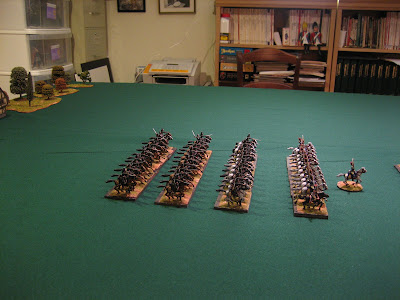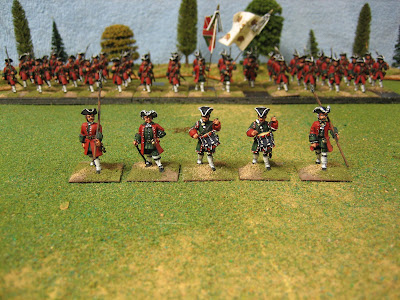It has been a "moderate" month in terms of my painting activity in January. The total number of Olley Painting Points was 93 points. This was actually more than I thought I had done - perhaps the fact that I did not paint full regiments made me think that I hadn't accomplished much. January was designated as "1806 Month" and my goal was to bring my 3 1806 Prussian battalions up to 60 figures and hopefully add a 60 figure grenadier battalion to my forces. As you can see from the list below, I fell a little bit short of my goal, but the total number of painting points was close to the sweet spot of "not too many, not too few" that is needed to maintain a balance in life between work, family and hobby and just plain relaxing. I decided that 60 to 72 points per month is a good target to shoot for.
I also played in one wargame during January, the small SYW action at Muhlenberg, which resulted in a French (Gallian) victory over the Prussians (Germania). I want to keep working on some smaller game scenarios throughout the year and I will share these with you as they occur.
Here is a list of what Der Alte Fritz painted in January:
I also played in one wargame during January, the small SYW action at Muhlenberg, which resulted in a French (Gallian) victory over the Prussians (Germania). I want to keep working on some smaller game scenarios throughout the year and I will share these with you as they occur.
Here is a list of what Der Alte Fritz painted in January:
1806 Project
IR13 von Arnim (white facings) - 21
IR19 Prinz von Oranien (orange facings) - 16
Osten Grenadiers (from IR22 - red) - 30
1er Chasseurs a Cheval - 1 mounted figure = 2 points
Seven Years War
RSM command stand dioramas - 12 figures in total
RSM Austrian Generals - 2 figures = 4 points
Coach driver and passenger - 2 figures
Riesengarde (Staddens) - 4 figures
Mounted Prussian officer - Prinz Moritz von Anhalt Dessau = 2 points
On The Painting Table
30 more 1806 Prussian Grenadiers
2 gun battery of 6-pounders for the 1806 Prussians
10 French Chasseurs a Cheval
15 SYW Stadden grenadierss which will become part of the Riesengarde
12 Crusader SYW Austrian cuirassiers
February is supposed to be SYW Austrian Cavalry Month, but I have a hankering to get those 1806 grenadiers completed. This will give me 4 battalions of Prussians and 3 battalions of French, which should be enough to start play testing a BAR variant for the 1806 campaign.
Eureka 100 Club SYW Saxon Cavalry
Nic Robison sent me an e-mail advising me that it was time to place orders for figures as he is ready to get these into production. Eureka will have a substantial range of Saxon cavalry which will include cuirassiers, light dragoons, von Bruhl dragoons and hussars in both mirliton and colpacks. The chevaulegers and hussars will also have horseholders and dismounted skirmishers. So Bill, Randy and I all ordered tons of hussars and dismounts so that we can use them in some Kleine Krieg scenarios. I envision painting my hussars as Milady de Winter's personal retinue of black hussars with the appropriate number of dismounts. The black uniforms will be modeled after one of the freikorps units that were in Prussian service during the SYW. I ordered some extra horse holders and kettle drummers to use for other units. I am really looking forward to seeing how these figures will turn out.
Eureka 100 Club SYW Saxon Cavalry
Nic Robison sent me an e-mail advising me that it was time to place orders for figures as he is ready to get these into production. Eureka will have a substantial range of Saxon cavalry which will include cuirassiers, light dragoons, von Bruhl dragoons and hussars in both mirliton and colpacks. The chevaulegers and hussars will also have horseholders and dismounted skirmishers. So Bill, Randy and I all ordered tons of hussars and dismounts so that we can use them in some Kleine Krieg scenarios. I envision painting my hussars as Milady de Winter's personal retinue of black hussars with the appropriate number of dismounts. The black uniforms will be modeled after one of the freikorps units that were in Prussian service during the SYW. I ordered some extra horse holders and kettle drummers to use for other units. I am really looking forward to seeing how these figures will turn out.













































